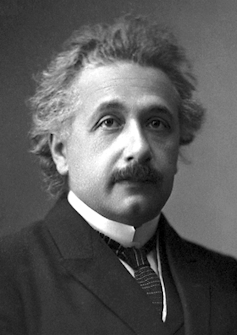Rost9/Shutterstock
What is exotic matter, and could we use it to make wormholes? – Julia, aged 14, London
Matter is “stuff”. It is anything that is made up of particles that take up space. Everything we can feel and see on Earth is matter, and it’s usually in one of three types: solid, liquid or gas. This could be the chair you’re sitting on, sea water, or the helium in a balloon.
There are other types of matter that do not behave like the gases, liquids or solids that we normally encounter on Earth. The ones that behave in the weirdest ways are called exotic matter.
We can create exotic matter in laboratories by cooling some materials to very low temperatures. Extremely cold helium is one example. It is called superfluid helium, and is a liquid that can climb walls.
It’s possible that exotic matter could one day explain some of the mysteries of space. It might be a key ingredient for making a wormhole.
Bending space and time
A wormhole is something that connects two places in the universe by bending space. A wormhole has never been found, but if it did exist then it could obey our laws of gravity.
In 1687, scientist Isaac Newton said that gravity is created by the mass of an object. The mass of an object is the amount of matter in it. This means that the more matter there is in the object then the bigger the gravitational pull towards that object.

Curious Kids is a series by The Conversation that gives children the chance to have their questions about the world answered by experts. If you have a question you’d like an expert to answer, send it to [email protected] and make sure you include the asker’s first name, age and town or city. We won’t be able to answer every question, but we’ll do our very best.
In 1915, physicist Albert Einstein changed our view of what creates gravity.
Einstein said that matter bends space. He said that moving objects will follow the curvature of this bent space, and it is this that creates the effect of gravity.

Nobel Foundation archive/Wikimedia Commons
For example, Earth is made of matter, and it makes the space around it bend. When objects move around the Earth they follow the bent space which makes them fall towards Earth. This is what we call gravity.
This curving of space caused by matter also affects time. The more curved space is, then the slower time passes. Because space and time are so closely connected, we often talk about space-time when investigating how the universe works.
A wormhole is formed by space-time curving in such a way that a tunnel forms between two separate regions in the universe. Where the tunnel comes out into space it is called the “mouth”. A wormhole has two mouths that can be separated by an enormous distance, and the tunnel itself is called the “throat”.
Creating a wormhole
One type of exotic matter that could be related to wormholes is matter with negative mass. All matter we know has a positive mass and is attracted to other matter due to gravity – like an apple falling to Earth. Matter with a negative mass would push other matter away from it.
The physicist Kip Thorne proposed that negative matter would be needed to keep a wormhole stable once it has formed. We have never detected negative matter, and we do not even know what it would look like, but it is something that we can put into equations and understand how it would behave if it did exist.
Read more:
What are wormholes? An astrophysicist explains these shortcuts through space-time
Although we can say what a wormhole is, we do not know how to create one, so we cannot know if exotic matter can make wormholes.
Wormholes are interesting to scientists and science fiction writers because there is a possibility that wormholes could link two regions in space that are far apart. If they did exist, we could perhaps travel vast distances across the universe in a short time.
![]()
Carolyn Devereux receives funding from STFC.











